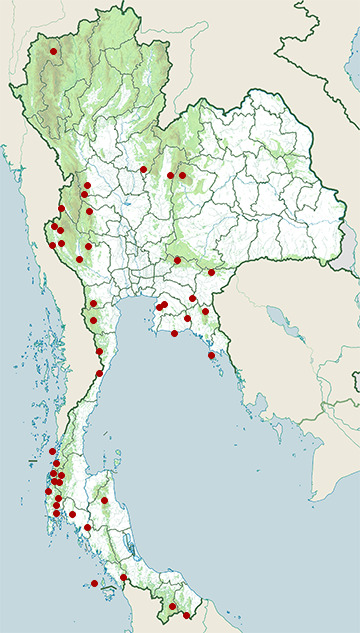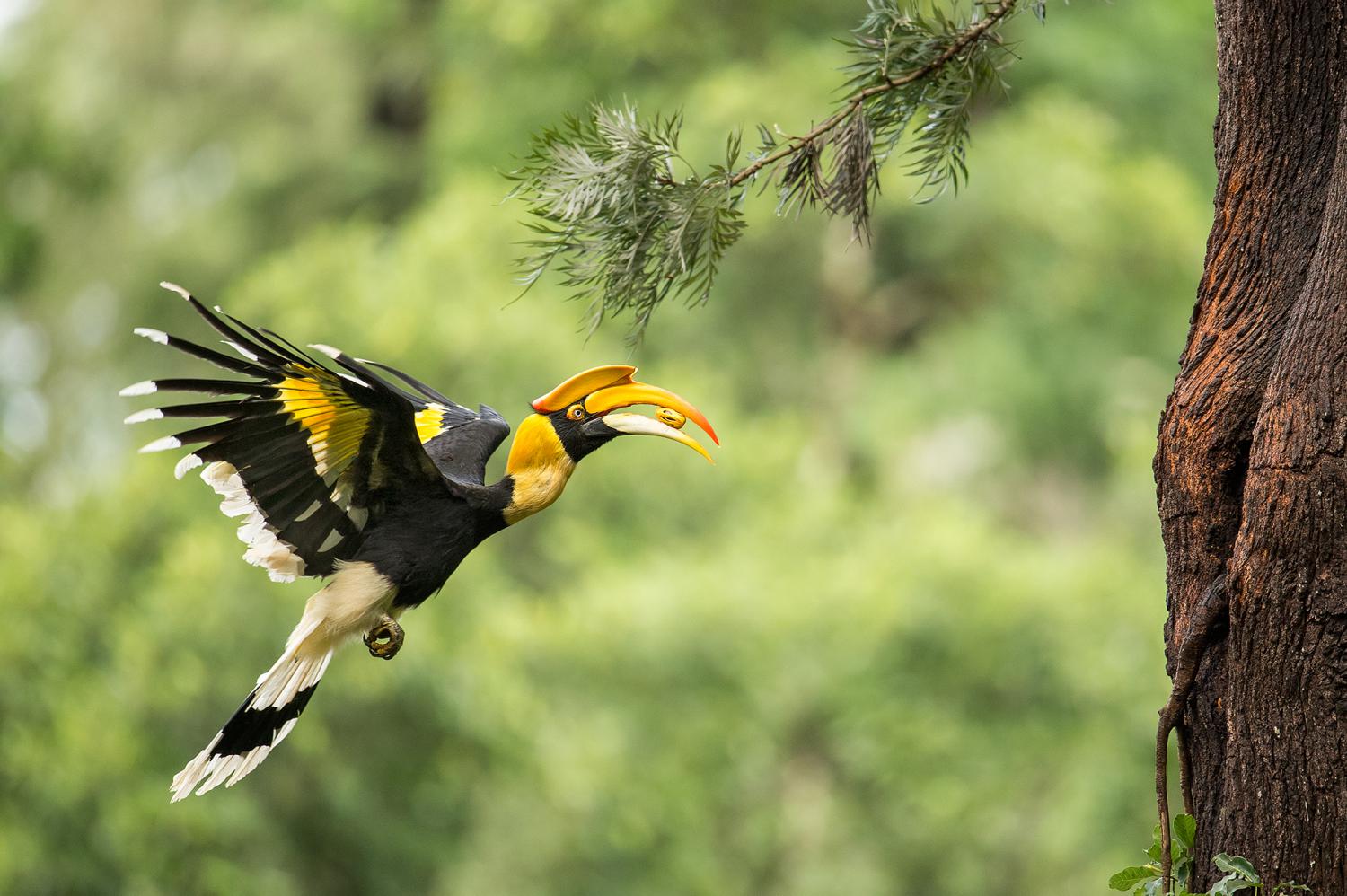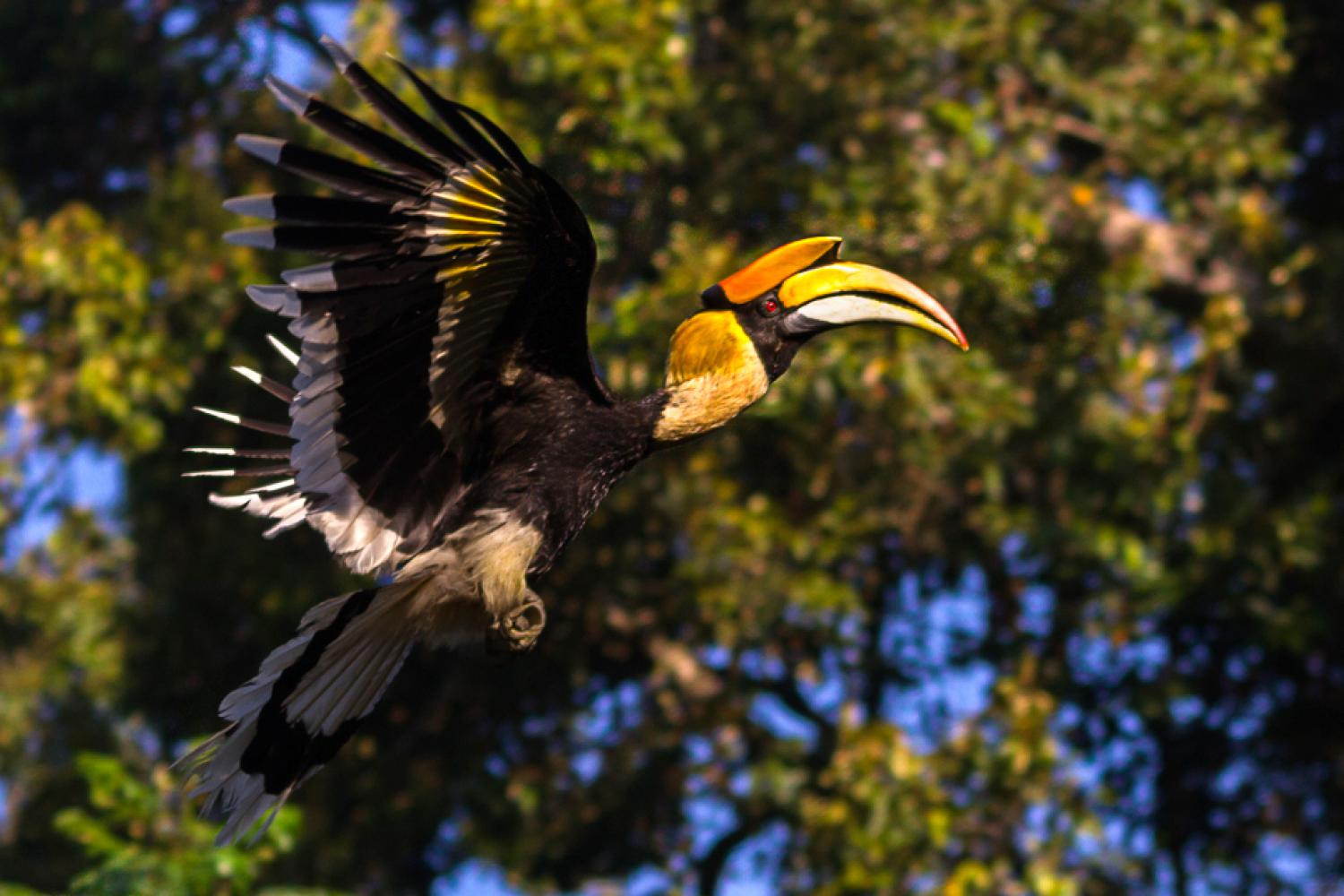Species of Thailand
Great hornbill
Buceros bicornis
Carolus Linnaeus, 1758
In Thai: นกกก, นกกาฮัง
The great hornbill (Buceros bicornis) also known as the concave-casqued hornbill, great Indian hornbill or great pied hornbill, is one of the larger members of the hornbill family. It is found in the Indian subcontinent and Southeast Asia. Its impressive size and colour have made it important in many tribal cultures and rituals. The great hornbill is long-lived, living for nearly 50 years in captivity. It is predominantly frugivorous, but is an opportunist and will prey on small mammals, reptiles and birds.
Description
The great hornbill is a large bird, 95 – 130 cm long, with a 152 cm wingspan and a weight of 2 to 4 kg. The average weight of 7 males was 3 kg whereas that of 3 females was 2.59 kg. It is the heaviest, but not the longest, Asian hornbill (falling second to the similarly weighted helmeted hornbill due to the latter's extremely long tail feathers). Females are smaller than males and have bluish-white instead of red eyes, although the orbital skin is pinkish. Like other hornbills, they have prominent "eyelashes".
The most prominent feature of the hornbill is the bright yellow and black casque on top of its massive bill. The casque appears U-shaped when viewed from the front, and the top is concave, with two ridges along the sides that form points in the front, whence the Latin species epithet bicornis (two-horned). The back of the casque is reddish in females, while the underside of the front and back of the casque is black in males.
The casque is hollow and serves no known purpose, although it is believed to be the result of sexual selection. Male hornbills have been known to indulge in aerial casque butting, with birds striking each other in flight. The male spreads the preen gland secretion, which is yellow, onto the primary feathers and bill to give them the bright yellow colour. The commissure of the beak is black and has a serrated edge which becomes worn with age.
The wing beats are heavy and the sound produced by birds in flight can be heard from a distance. This sound has been likened to the puffing of a steam locomotive starting up. The flight involves stiff flaps followed by glides with the fingers splayed and upcurled. They sometimes fly at great height over forests.
Taxonomy
The species was formerly broken into subspecies cavatus, from the Western Ghats, and homrai, the nominate form from the sub-Himalayan forests. The subspecies from Sumatra was sometimes called cristatus. Variation across populations is mainly in size, Himalayan birds being larger than those from further south, and the species is now usually considered monotypic.
Like other members of the hornbill family, they have highly pneumatized bones, with hollow air cavities extending to the tips of the wing bones. This anatomical feature was noted by Richard Owen, who dissected a specimen that died at the Zoological Society of London in 1833.
Distribution and habitat
Great hornbills are found in the forests of India, Bhutan, Nepal, Mainland Southeast Asia, Indonesian Island of Sumatra and North eastern region of India. The distribution of the species is fragmented over its range in the Indian subcontinent and Southeast Asia. In the subcontinent they are found in a few forest areas in the Western Ghats and in the forests along the Himalayas. Deforestation has reduced their range in many parts of India such as in the Kolli hills where they were recorded in the 1860s. Their distribution extends into Thailand, Burma, Malaya, and Sumatra. A small feral population is found in Singapore. Their habitat is dense old growth (unlogged) forests in hilly regions. They appear to be dependent on large stretches of forest, unlike many of the smaller hornbills.
In Thailand the home range of males was found to be about 3.7 km2 during the breeding season and about 14.7 km2 during the non-breeding season.
Food and feeding
Great hornbills are usually seen in small parties, with larger groups sometimes aggregating at fruit trees. A congregation of 150 to 200 birds has been recorded in southeastern Bhutan. In the wild, the great hornbill's diet consists mainly of fruit. Figs are particularly important as a food source. Vitex altissima has been noted as another important food source. Great hornbills also forage on lipid-rich fruits of the families Lauraceae and Myristicaceae such as Persea, Alseodaphne and Myristica. They obtain the water that they need entirely from their diet of fruits. They are important dispersers of many forest tree species. They will also eat small mammals, birds, small reptiles and insects. Lion-tailed macaques have been seen to forage alongside these hornbills.
They forage along branches, moving along by hopping, looking for insects, nestling birds and small lizards, tearing up bark and examining them. Prey are caught, tossed in the air and swallowed. A rare squirrel, the Travancore flying squirrel (Petinomys fuscocapillus) has been eaten, and Indian scops owl (Otus bakkamoena), jungle owlet (Glaucidium radiatum) and Sri Lanka green pigeon (Treron pompadora) have been taken as prey in the Western Ghats.
Breeding
During the breeding season (January to April) great hornbills become very vocal. They make loud duets, beginning with a loud "kok" given about once a second by the male, to which the female joins in. The pair then calls in unison, turning into a rapid mixture of roars and barks. They prefer mature forests for nesting. Large, tall and old trees, particularly emergents that rise above the canopy, seem to be preferred for nesting. They form monogamous pair bonds and live in small groups of 2-40 individuals. Group courtship displays involving up to 20 birds have been observed.
The female hornbill builds a nest in the hollow of a large tree trunk, sealing the opening with a plaster made up mainly of feces. She remains imprisoned there, relying on the male to bring her food, until the chicks are half developed. During this period the female undergoes a complete moult. The young chicks have no feathers and appear very plump. The mother is fed by her mate through a slit in the seal. The clutch consists of one or two eggs, which she incubates for 38–40 days. The female voids feces through the nest slit, as do the chicks from the age of two weeks. Once the female emerges from the nest, the chicks seal it again.
The young birds have no trace of a casque. After the second year the front extremity separates from the culmen, and in the third year it becomes a transverse crescent with the two edges growing outwards and upwards, while the anterior widens to the width of the rear end. Full development takes five years.
Roosting
Roost sites are used regularly and birds arrive punctually at sunset from long distances, following the same routes each day. Several tall trees in the vicinity may be used, the birds choosing the highest branches with little foliage. They jockey for position until late at dusk. When sleeping they draw their neck back and the bill is held upwards at an angle.
In captivity
Very few hornbills are held in captivity, and few of them breed well. Females at the nests are extremely easy to capture, and birds caught in the wild are mostly female. Breeding them in captivity has been notoriously difficult, with fewer than a dozen successful attempts. Their extreme selectivity for mates and their long and strong pair bonds make them difficult to maintain for breeding.
In captivity hornbills eat fruits and meat, a healthy diet consisting mostly of fruit and some source of protein. A few have been tamed in captivity but hornbill behavior in captivity is described as highly strung. Captive specimens may bask in the sun with outstretched wings.
A captive great hornbill, named Jari, in Jurong Bird Park, Singapore, was fitted with a prosthetic casque manufactured using 3D printing after losing his original casque to cancer. Jari coloured his prosthetic casque yellow using pigment from his tail gland.
Conservation status
Due to habitat loss and hunting in some areas, the great hornbill is evaluated as vulnerable on the IUCN Red List of Threatened Species. (uplisted from near threatened in 2018). It is listed in Appendix I of CITES. Declines in population have been noted in many areas such as Cambodia. In Southeast Asia, birds are frequently shot at by poachers who mistake the species for the highly sought-after helmeted hornbill. Molecular approaches to the study of their population diversity have been attempted.
In culture
Tribal peoples threaten the great Indian hornbill by hunting it for its various parts. The beaks and head are used in charms and the flesh is believed to be medicinal. Young birds are considered a delicacy. Tribesmen in parts of northeastern India and Borneo use the feathers for head-dresses, and the skulls are often worn as decorations. The Sema Nagas consider the flesh unfit for eating, believing that it produces sores on their feet, as in the bird. When dancing with the feathers of the hornbill, they avoid eating vegetables, as doing so is also believed to produce the same sores on the feet. Among the Zomi, a festival without a hornbill feather is incomplete. Conservation programmes have attempted to provide tribes with feathers from captive hornbills and ceramic casques to substitute for natural ones.
The great hornbill is called homrai in Nepal (hence the name of the Himalayan subspecies) and banrao, both meaning "king of the forest". It is called "Vezhaambal" in Malayalam.
Use as a symbol
The great hornbill is the state bird of Kerala and Arunachal Pradesh in India.
The Great Hornbill is used as the logo of Kerala Evergreen FC an Indian professional football club based in Thiruvananthapuram, Kerala, India, that competes in the I-League
A great hornbill called William (pictured) was the model for the logo of the Bombay Natural History Society (BNHS) and the name of their building. Sir Norman Kinnear described William as follows in the obituary of W S Millard:
"Every visitor to the Society's room in Apollo Street will remember the great Indian Hornbill, better known as the "office canary" which lived in a cage behind Millard's chair in Phipson & Co.'s office for 26 years and died in 1920. It is said its death was caused by swallowing a piece of wire, but in the past "William" had swallowed a lighted cigar without ill effects and I for my part think that the loss of his old friend was the principal cause."
This article uses material from Wikipedia released under the Creative Commons Attribution-Share-Alike Licence 3.0. Eventual photos shown in this page may or may not be from Wikipedia, please see the license details for photos in photo by-lines.
Category / Seasonal Status
BCST Category: Recorded in an apparently wild state within the last 50 years
BCST Seasonal status: Resident or presumed resident
Scientific classification
- Kingdom
- Animalia
- Phylum
- Chordata
- Class
- Aves
- Order
- Bucerotiformes
- Family
- Bucerotidae
- Genus
- Buceros
- Species
- Buceros bicornis
Common names
- Thai: นกกก, นกกาฮัง
Synonyms
- Homraius bicornis
- Buceros cavatus
- Dichoceros bicornis
- Buceros homrai
Conservation status

Near Threatened (IUCN3.1)

Vulnerable (BirdLife)

Vulnerable (ONEP)

Near Threatened (BCST)
Photos
Please help us review the bird photos if wrong ones are used. We can be reached via our contact us page.
Range Map

- Ao Phang-Nga National Park
- Ban Bueng District, Chonburi
- Bang Lang National Park
- Chaloem Rattanakosin National Park
- Erawan National Park
- Hala-Bala Wildlife Sanctuary
- Huai Kha Khaeng Wildlife Sanctuary
- Huai Yang Waterfall National Park
- Kaeng Krachan National Park
- Khao Ang Rue Nai Wildlife Sanctuary
- Khao Chamao - Khao Wong National Park
- Khao Laem National Park
- Khao Laem Ya - Mu Ko Samet National Park
- Khao Luang National Park
- Khao Phanom Bencha National Park
- Khao Phra - Bang Khram Wildlife Sanctuary
- Khao Soi Dao Wildlife Sanctuary
- Khao Sok National Park
- Khao Yai National Park
- Khlong Lan National Park
- Khlong Nakha Wildlife Sanctuary
- Khlong Saeng Wildlife Sanctuary
- Khura Buri District, Phang Nga
- Ko Chang National Park
- Ko Phayam
- Kui Buri National Park
- Mae Wong National Park
- Mueang Phang Nga District, Phang Nga
- Pachee River Wildlife Sanctuary
- Pai District, Mae Hong Son
- Pang Sida National Park
- Phu Khiao Wildlife Sanctuary
- Sangkhla Buri District, Kanchanaburi
- Si Racha District, Chonburi
- Sri Phang Nga National Park
- Takua Pa District, Phang Nga
- Tarutao National Marine Park
- Tat Mok National Park
- Thale Ban National Park
- Tham Pha Tha Phon Non-Hunting Area
- Thong Pha Phum District, Kanchanaburi
- Thong Pha Phum National Park
- Thung Yai Naresuan Wildlife Sanctuary
- Ton Pariwat Wildlife Sanctuary




